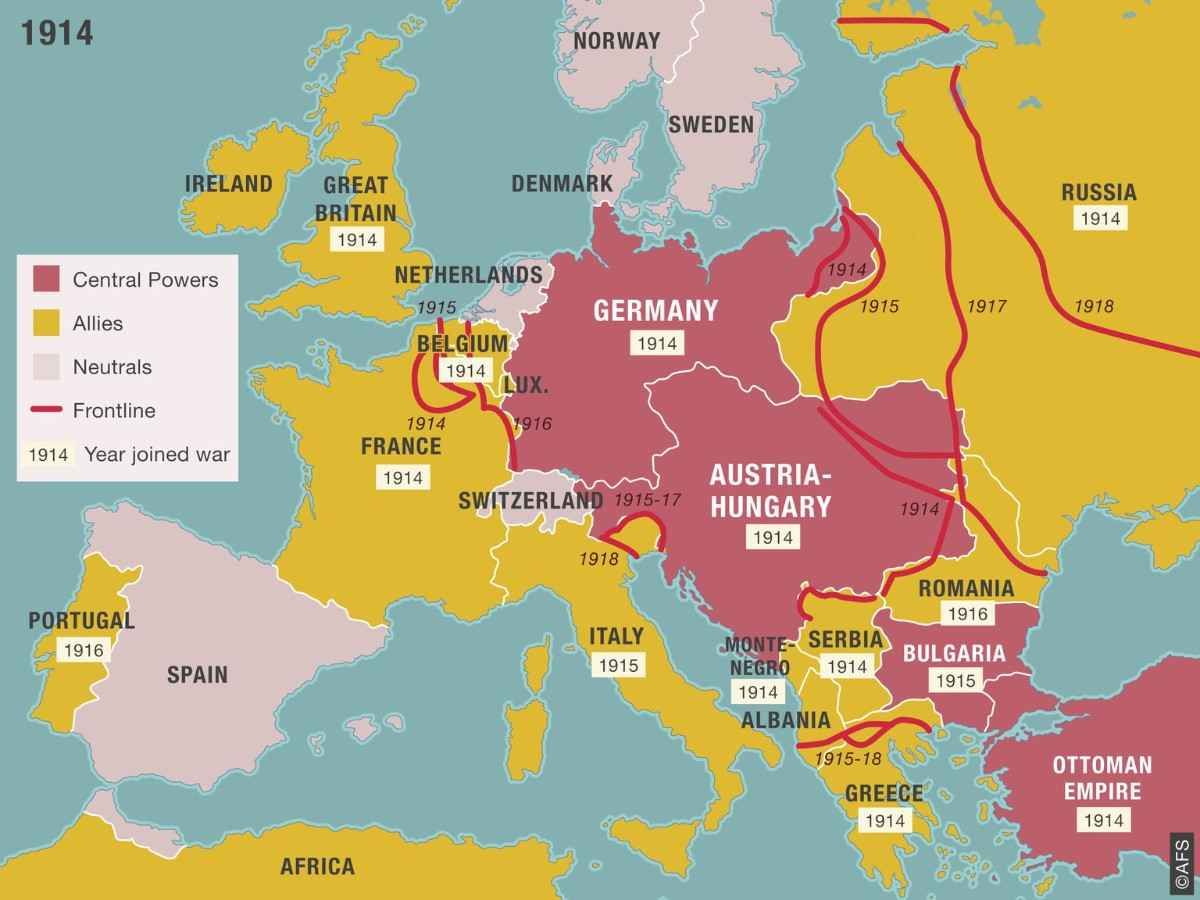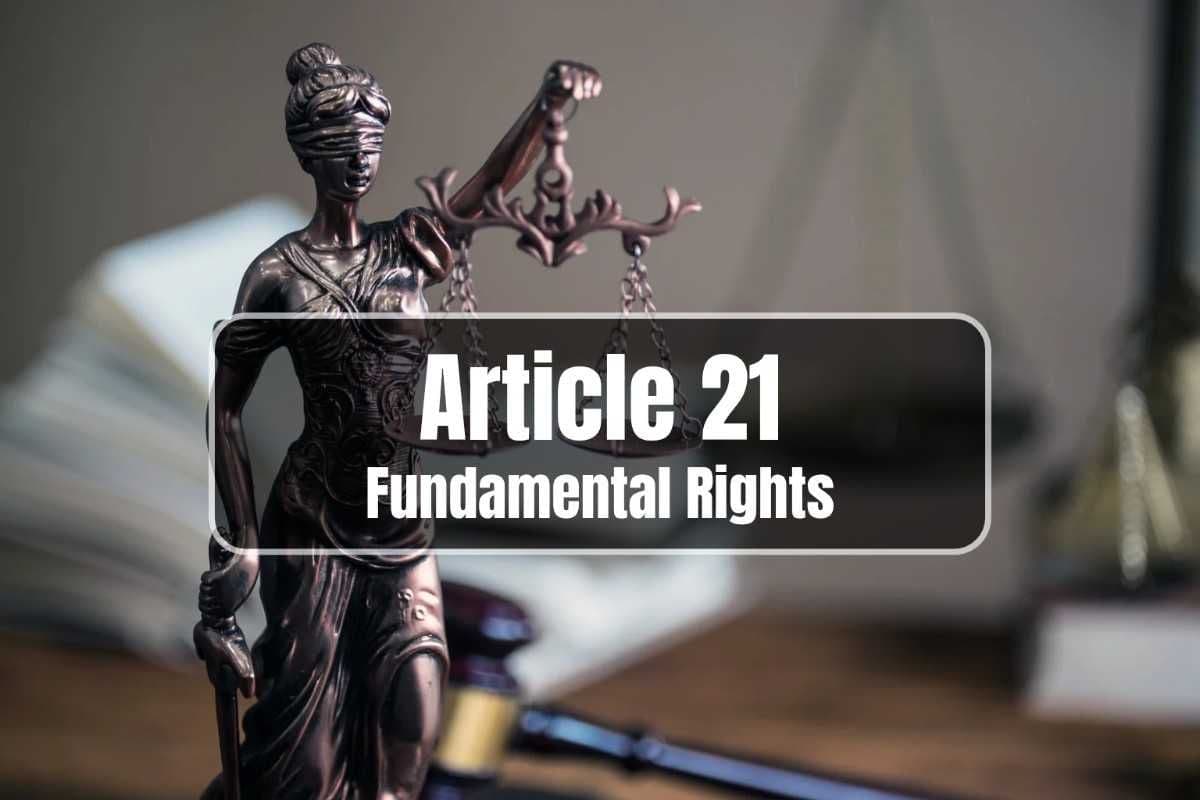UPSC Notes on First World War: Causes, Consequences & Key Treaties
Oct, 2025
•4 min read
The First World War is a key historical event that transformed global politics, ended empires, and set the stage for new nations. For India, its consequences fueled nationalist movements and shaped modern international relations.
Learning about the First World War is important for UPSC aspirants, especially for the World History and International Relations portions of General Studies Papers 1 and 2. It is also important for linking India’s freedom struggle to major global events and analysing current affairs.
About the First World War
The First World War, also known as the Great War, was a massive global conflict that lasted from 28 July 1914 to 11 November 1918. The war was sparked by the assassination of Archduke Franz Ferdinand of Austria. It was fought between two major coalitions:
- The Allies (also called the Entente Powers, which included Britain, France, Russia, Italy, Japan, and later the United States).
- The Central Powers (Germany, Austria-Hungary, Ottoman Empire, and Bulgaria).
This war started in Europe but gradually spread across the globe, involving major world powers and their colonial empires.

Key Facts About World War 1
- The war began on July 28, 1914, when Austria-Hungary declared war on Serbia and ended with the Armistice on November 11, 1918.
- The war introduced tanks, aircraft, chemical weapons (like poisonous gas), and advanced artillery that made fighting more deadly than ever before.
- Over 1.3 million Indian soldiers served in the war, with approximately 60,000-74,000 dying for the British Empire.
- The United States entered the war on April 6, 1917, which gave the Allies a fresh boost in strength.
- Four major empires fell: the Russian, German, Austro-Hungarian, and Ottoman Empires.
- The League of Nations was created after the war to prevent future conflicts, though the United States ironically did not join.
Understanding the Background & Causes of World War I
The First World War didn't happen because of just one event. Many long-term tensions and problems built up in Europe over several decades, and then a single incident sparked the entire conflict.
- Assassination at Sarajevo: On June 28, 1914, Archduke Franz Ferdinand of Austria and his wife Sophie were assassinated by Gavrilo Princip, a 19-year-old Bosnian Serb nationalist, in Sarajevo.
- Chain Reaction: Due to alliance commitments, Austria-Hungary declared war on Serbia on July 28, 1914, triggering declarations of war across Europe within weeks.
- Nationalism: Rising national pride and ethnic tensions, especially in multi-ethnic empires like Austria-Hungary and the Ottoman Empire, created volatile situations.
- Imperialism: European powers competed fiercely for colonies in Africa and Asia, leading to increased rivalries and conflicts.
- Militarism: Countries built large armies and stockpiled weapons, creating an arms race that made war seem inevitable.
- Alliance System: A Complex web of defensive pacts divided Europe into two hostile camps, making any small conflict likely to expand.
- Balance of Power Disruption: Rise of Germany and decline of the Ottoman Empire disturbed the long-standing European power equilibrium.
- Balkan Instability: Multiple crises in the Balkans created a "powder keg" situation.
Also read: Best History Books for UPSC IAS Preparation: Ancient, Medieval, Modern, and World History
Phases of the First World War
The war progressed through distinct phases marked by different strategies, battles, and turning points. Let’s understand those phases in detail.
Phase 1: Opening Campaigns (1914)
- German Strategy: Germany executed the Schlieffen Plan, aiming for a quick victory over France before turning to Russia.
- Western Front Established: First Battle of the Marne (September 5-12, 1914) halted the German advance just 30 miles from Paris.
- Trench Warfare Begins: By the end of 1914, a continuous line of trenches stretched from the English Channel to Switzerland.
- Eastern Front: Battle of Tannenberg (August 26-30, 1914) saw Germany defeat Russia, but Russian mobilisation diverted German troops from the West.
- Indian Troops Arrive: The Indian Expeditionary Force reached the Western Front in September 1914.
Phase 2: Stalemate and Attrition (1915-1917)
- War of Attrition: Both sides suffered massive casualties with minimal territorial gains.
- Battle of Verdun (1916): Germany's strategy to "bleed France white" resulted in over 700,000 combined casualties.
- Battle of the Somme (1916): Allied offensive caused over one million casualties with little strategic gain.
- Battle of Gallipoli (1915-1916): Failed Allied campaign to knock Ottoman Turkey out of the war.
- Chemical Warfare: Germany first used poison gas at the Second Battle of Ypres in 1915.
- Italian Involvement: Italy joined the Allies in May 1915.
- Naval Blockade: The British blockade of Germany created severe shortages.
Phase 3: Turning Point (1917)
- Russian Revolution and Withdrawal: February and October Revolutions in 1917 led to Russia's exit from the war.
- Treaty of Brest-Litovsk: Russia formally withdrew on March 3, 1918, ceding territory to Germany.
- American Entry: The United States entered the war on April 6, 1917, providing crucial manpower and resources.
- Reasons for US Entry: Zimmermann telegram and unrestricted submarine warfare.
Phase 4: Final Offensive and Allied Victory (1918)
- German Spring Offensive: Germany launched major attacks but failed to achieve a breakthrough.
- Allied Counter Offensive: Starting in August 1918, the Allies pushed back German forces with American reinforcements.
- American Contribution: Over 1.2 million US troops in France by September 1918.
- Central Powers Collapse: Turkey and Austria-Hungary were defeated by October 1918.
- Armistice: Fighting ceased at 11 AM on November 11, 1918.
Get access to World History Notes Strategy for UPSC IAS Civil Services Exam Preparation
What are the Consequences of the First World War?
The war's impact reshaped the world politically, economically, and socially in profound ways. Let’s understand how!
1. Political Consequences
- End of Monarchies: Four major monarchies collapsed - the Russian Tsar, the German Kaiser, the Austro-Hungarian Emperor, and the Ottoman Sultan.
- New Countries Created: Poland, Czechoslovakia, Yugoslavia, Finland, Estonia, Latvia, and Lithuania emerged as independent nations.
- Imperial Dissolution: Austria-Hungary and the Ottoman Empires completely dissolved.
- Colonial Changes: German colonies became League of Nations Mandates distributed among the Allies.
- Rise of Extremism: War conditions facilitated the rise of communism in Russia and later fascism in Germany and Italy.
- Seeds of World War II: Harsh treaty terms, particularly on Germany, created resentment, leading to another global conflict.
2. Economic Consequences
- Massive War Debt: Countries accumulated enormous debts, with the US becoming the world's greatest creditor.
- Economic Disruption: Germany and Great Britain spent about 60% of their GDP on war.
- Reconstruction Challenges: European economies faced years of recovery with damaged infrastructure and depleted resources
- Reparations Burden: Germany was required to pay massive reparations, causing economic hardship.
- Trade Barriers: End of the first globalisation era, as countries erected trade barriers and capital controls.
- US Economic Dominance: The United States accumulated 70% of the world's gold reserves by 1947.
3. Social Consequences
- Massive Casualties: Over 16 million people died (military and civilian), with 21 million more wounded.
- Lost Generation: An Entire generation of young men was wiped out, creating a demographic imbalance.
- Women's Changing Roles: Women entered the workforce in unprecedented numbers, replacing men in factories and offices.
- Women's Suffrage Advancement: Many countries granted women voting rights after the war, including the UK (1918) and the US (1920).
- Social Upheaval: Upper classes lost their leading role as middle and lower classes demanded greater say in governance.
- Class Restructuring: Traditional social hierarchies challenged and transformed.
Major Treaties of World War I (UPSC Syllabus Relevance)
Multiple peace treaties were signed to formally end the war and reshape the post-war world.
1. Treaty of Versailles (June 28, 1919)
The treaty was signed between the Allied Powers and Germany at the Palace of Versailles.
- War Guilt Clause: Article 231 forced Germany to accept complete responsibility for the war.
- Territorial Losses: Germany lost 13% of its territory, including Alsace-Lorraine to France, territories to Poland, Belgium, and Denmark.
- Military Restrictions: The German army was limited to 100,000 men, no air force, limited navy.
- Demilitarised Rhineland: German border region occupied and demilitarized.
- League of Nations: The Covenant was included in the treaty, though the US never ratified.
2. Treaty of Saint-Germain (September 10, 1919)
The treaty was signed between the Allied Powers and Austria.
- Empire Dissolution: Officially registered breakup of the Habsburg Austro-Hungarian Empire.
- New Nations Recognised: Independence of Czechoslovakia, Poland, Hungary, and Yugoslavia acknowledged.
- Territorial Losses: Austria ceded territories to Italy, Poland, Czechoslovakia, and Yugoslavia.
- Anschluss Forbidden: Union with Germany was explicitly prohibited without League consent.
3. Treaty of Trianon (June 4, 1920)
This treaty was signed at the Grand Trianon Palace at Versailles.
- Massive territorial Loss: Hungary lost two-thirds of its territory and population.
- Beneficiaries: Czechoslovakia, Romania, and Yugoslavia gained Hungarian territories.
- Military Limits: The Army was restricted to 35,000 lightly armed men.
- National Catastrophe: The Treaty was considered a disastrous failure of the Hungarian unification program.
4. Treaty of Neuilly (November 27, 1919)
The treaty was signed between the Allied Powers and Bulgaria.
- Territorial Loss: Bulgaria lost Western Thrace to Greece, territories to Yugoslavia and Romania.
- Aegean Access Lost: Bulgaria deprived of direct outlet to the Aegean Sea.
- Population Exchange: Convention signed with Greece for population transfers.
5. Treaty of Sèvres (August 10, 1920)
This treaty was signed to partition the Ottoman Empire.
- Middle East Division: France took Syria and Lebanon, Britain took Palestine and Iraq.
- Independent Nations: Armenia recognised as an independent state.
- Greek Expansion: Greece gained control of Smyrna and the Aegean islands.
- Never Implemented: Turkish nationalists under Mustafa Kemal Atatürk rejected the treaty.
- Replaced by Lausanne: Treaty of Lausanne (1923) superseded Sèvres after the Turkish War of Independence.
Also cover: Israel-Iran War: Historical Background, Challenges and Implications
Multiple Choice Questions
QUESTION 1
Easy
When did World War I begin?
Select an option to attempt
India in World War I: Participation and Aftermath
India's role in World War I is often forgotten, but it changed the course of Indian history. Over 1.5 million Indian soldiers fought for Britain, expecting freedom in return. Instead, they got betrayal, and this betrayal sparked India's mass independence movement.
1. "England's Need is India's Opportunity": When war broke out in 1914, Indian leaders saw a golden opportunity. Annie Besant, a famous nationalist leader, said: "England's need is India's opportunity."
India's Contribution was Massive:
- Over 1.3 to 1.5 million soldiers and workers served in the war.
- Even Mahatma Gandhi supported the war, believing it would help India gain freedom.
2. The Battle of Ypres: In September 1914, Indian soldiers reached the Western Front, enduring freezing winters, muddy trenches, and relentless gunfire. At the First Battle of Ypres, their courage earned them the title “Lions of the Punjab.”
- In 1914, Sepoy Khudadad Khan fought bravely against German forces despite being wounded. He became the first Indian and Muslim to be awarded the Victoria Cross for his heroism by King George V.
3. The British Promise: On 20 August 1917, British leader Edwin Montagu announced that Britain would work toward gradually giving India self-government.
- Annie Besant proudly declared: "The price of India's loyalty is India's freedom."
- Indian soldiers believed they were fighting not just for Britain, but for their own country's independence.
4. The Great Betrayal - The Rowlatt Act (1919): When the war ended in 1918, Indians hoped for rewards. But in March 1919, the British passed the Rowlatt Act, a harsh and unfair law.
Indians called it the "Black Act" because it was so harsh:
- Police could arrest anyone without a warrant
- Suspects could be jailed for 2 years without trial
- No right to a lawyer or court appeal
- The government could ban newspapers and meetings
- This wasn't just disappointing; it felt like a slap in the face.
5. Limited Reforms - Too Little, Too Late: The British also passed the Government of India Act 1919, which introduced a system called "diarchy." Under this system:
- Indians could control some local matters like education and agriculture.
- But Britain kept complete control over defence, foreign affairs, police, and money.
Annie Besant dismissed these reforms as "unworthy of England to offer and India to accept.”
6. India Rises - From Protests to Revolution: Gandhi launched the Rowlatt Satyagraha on 6 April 1919, calling for peaceful protests across India. Millions of people participated:
- Shops closed
- Workers went on strike
- Peaceful marches filled the streets
The British response was brutal. On 13 April 1919, at Jallianwala Bagh in Amritsar, British General Reginald Dyer ordered soldiers to fire on a peaceful gathering during the Baisakhi festival.
7. The Non-Cooperation Movement (1920): By 1920, India had changed completely. Gandhi launched the Non-Cooperation Movement, which was different from earlier movements:
- It demanded complete independence (not just reforms).
- It was a mass movement involving millions of ordinary people.
- People boycotted British goods, schools, courts, and jobs.
The war changed how Indians thought. Soldiers who fought in Europe saw that the British were not unbeatable. They had watched European countries fight each other and realised Indians were just as strong and brave.
The older leaders who supported British rule lost influence, and a new generation began to demand Purna Swaraj, complete independence.
Also read: Non-Aligned Movement: History, Objectives, and Global Impact
UPSC Mains Practice Question
What were the immediate triggers and the underlying causes of World War I?
Evaluate Your Answers nowConclusion
The First World War stands as a watershed moment in human history that fundamentally transformed the global order. Here’s how:
- End of Old Order: Four major empires collapsed - Russian, German, Austro-Hungarian, and Ottoman.
- Birth of the New World: New independent countries like Poland, Czechoslovakia, and Yugoslavia were created.
- Technological Revolution: Tanks, aircraft, chemical weapons, and machine guns were introduced in warfare.
- Social Transformation: Women gained voting rights and entered the workforce in large numbers.
- Economic Upheaval: Huge war debts and inflation led to an economic crisis.
Unlock your UPSC success with SuperKalam!
Get instant doubt clearance, customised study plans, unlimited MCQ practice, and fast Mains answer evaluation.
Explore SuperKalam's Resources and set yourself on the path to success!
Crack UPSC with your Personal AI Mentor
An AI-powered ecosystem to learn, practice, and evaluate with discipline
Download the SuperKalam App Now
![PM MUDRA Yojana 2025: Shishu to Tarun [UPSC Notes]](/_next/image?url=https%3A%2F%2Fblog-media.superkalam.com%2FPM_Mudra_Yojana_e5ffe37cf1.jpeg&w=3840&q=75)
